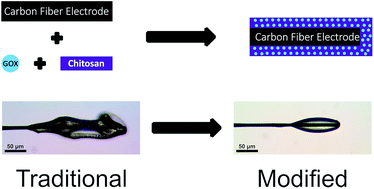当前位置:
X-MOL 学术
›
Anal. Methods
›
论文详情
Our official English website, www.x-mol.net, welcomes your feedback! (Note: you will need to create a separate account there.)
Improved formation of electrically-deposited enzyme-embedded chitosan coatings onto carbon fiber microelectrodes†
Analytical Methods ( IF 3.1 ) Pub Date : 2018-03-14 00:00:00 , DOI: 10.1039/c7ay02922e Caitlin E. T. Donahue 1, 2, 3, 4 , David R. Miller 1, 2, 3, 4 , Tyler W. Beger 1, 2, 3, 4 , Timothy W. Johann 1, 2, 3, 4 , Richard B. Keithley 1, 2, 3, 4
Analytical Methods ( IF 3.1 ) Pub Date : 2018-03-14 00:00:00 , DOI: 10.1039/c7ay02922e Caitlin E. T. Donahue 1, 2, 3, 4 , David R. Miller 1, 2, 3, 4 , Tyler W. Beger 1, 2, 3, 4 , Timothy W. Johann 1, 2, 3, 4 , Richard B. Keithley 1, 2, 3, 4
Affiliation

|
A significant challenge in the preparation of enzyme modified electrodes is the immobilization of enzyme near the electrode surface. Traditionally, the polysaccharide chitosan can be electrodeposited around an electrode by the application of a moderately negative voltage, causing an increase in the local pH, triggering its precipitation onto the electrode and immobilizing enzyme in the process. Unfortunately, the production of hydrogen gas bubbles during film deposition is well known to result in the formation of incomplete or non-uniform coatings. In this technical note, the simple addition of a redox-active proton consumer into the chitosan deposition solution is shown to improve the uniformity, reproducibility, and throughput of glucose oxidase-embedded chitosan-coated carbon fiber microelectrodes (GOX/CHIT-CFMs) appropriate for fast scan cyclic voltammetry. GOX/CHIT-CFMs produced through the reduction of benzoquinone and chloramphenicol showed no significant difference in enzyme performance, sensitivity, limit of detection, or time response as compared to those produced through the traditional approach, though throughput was much higher and film morphology was more uniform and reproducible. Benzoquinone displayed some reactivity when added to the coating solution which resulted in slightly thicker coatings that were morphologically distinct from those produced by either the traditional approach or with chloramphenicol. The addition of the antibiotic chloramphenicol, however, showed no such effect and is amenable for preparing GOX/CHIT-CFMs with high throughput. Overall, this work enables the production of more robust enzyme-embedded chitosan electrode films onto carbon fiber microelectrodes without sacrificing their performance.
中文翻译:

改进的在碳纤维微电极上电沉积的酶包埋的壳聚糖涂层的形成†
制备酶修饰电极的重大挑战是将酶固定在电极表面附近。传统上,多糖壳聚糖可通过施加适度的负电压在电极周围电沉积,从而导致局部pH值升高,触发其沉淀到电极上,并在此过程中固定酶。不幸的是,众所周知,在膜沉积过程中产生氢气气泡会导致形成不完整或不均匀的涂层。在本技术说明中,显示了在壳聚糖沉积溶液中简单添加氧化还原活性质子消耗剂可提高均匀性,可重复性,葡萄糖氧化酶包埋的壳聚糖涂层碳纤维微电极(GOX / CHIT-CFMs)的通量和通量,适用于快速扫描循环伏安法。通过还原苯醌和氯霉素生产的GOX / CHIT-CFM与传统方法生产的酶相比,酶性能,灵敏度,检测限度或时间响应均无显着差异,尽管通量高得多且膜形态更明显统一且可复制。当苯甲醌添加到涂料溶液中时,会表现出一定的反应性,从而导致涂料的厚度略厚,这与传统方法或氯霉素生产的涂料在形态上截然不同。但是,添加了抗生素氯霉素 显示没有这种效果,并且适合制备高通量的GOX / CHIT-CFM。总的来说,这项工作能够在不牺牲其性能的情况下,在碳纤维微电极上生产出更坚固的嵌入酶的壳聚糖电极膜。
更新日期:2018-03-14
中文翻译:

改进的在碳纤维微电极上电沉积的酶包埋的壳聚糖涂层的形成†
制备酶修饰电极的重大挑战是将酶固定在电极表面附近。传统上,多糖壳聚糖可通过施加适度的负电压在电极周围电沉积,从而导致局部pH值升高,触发其沉淀到电极上,并在此过程中固定酶。不幸的是,众所周知,在膜沉积过程中产生氢气气泡会导致形成不完整或不均匀的涂层。在本技术说明中,显示了在壳聚糖沉积溶液中简单添加氧化还原活性质子消耗剂可提高均匀性,可重复性,葡萄糖氧化酶包埋的壳聚糖涂层碳纤维微电极(GOX / CHIT-CFMs)的通量和通量,适用于快速扫描循环伏安法。通过还原苯醌和氯霉素生产的GOX / CHIT-CFM与传统方法生产的酶相比,酶性能,灵敏度,检测限度或时间响应均无显着差异,尽管通量高得多且膜形态更明显统一且可复制。当苯甲醌添加到涂料溶液中时,会表现出一定的反应性,从而导致涂料的厚度略厚,这与传统方法或氯霉素生产的涂料在形态上截然不同。但是,添加了抗生素氯霉素 显示没有这种效果,并且适合制备高通量的GOX / CHIT-CFM。总的来说,这项工作能够在不牺牲其性能的情况下,在碳纤维微电极上生产出更坚固的嵌入酶的壳聚糖电极膜。


























 京公网安备 11010802027423号
京公网安备 11010802027423号